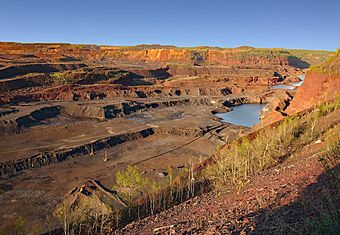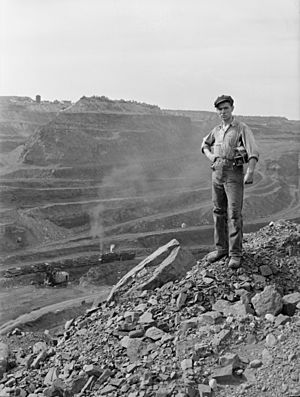Hull–Rust–Mahoning Open Pit Iron Mine facts for kids
|
Hull-Rust-Mahoning Open Pit Iron Mine
|
|

The Hull–Rust–Mahoning Mine from an overlook
|
|
| Location | off 3rd Avenue E., Hibbing, Minnesota |
|---|---|
| Built | 1895–present |
| NRHP reference No. | 66000904 |
Quick facts for kids Significant dates |
|
| Added to NRHP | November 13, 1966 |
| Designated NHL | November 13, 1966 |
The Hull–Rust–Mahoning Open Pit Iron Mine is a giant hole in the ground in Hibbing, Minnesota. It's the biggest operating open-pit iron mine in Minnesota. An open-pit mine is a type of mine where minerals are dug up from the surface, not from underground tunnels.
This huge mine is over 3 miles (4.8 km) long and 2 miles (3.2 km) wide. It's also about 535 feet (163 m) deep, which is taller than many skyscrapers! It started way back in 1895. It was one of the first mines in the world to use big machines for digging.
This mine is in a place called the Mesabi Range. During its busiest times, from World War I through World War II, it supplied a quarter of all the iron ore mined in the United States. Iron ore is the rock from which we get iron, a metal used to make steel.
Because of this mine's huge output, Minnesota became the top iron ore producer in the nation. This also helped the U.S. become the world's biggest maker of steel.
The Hull–Rust–Mahoning Mine was named a National Historic Landmark in 1966. This means it's a very important historical site in the United States. You can visit a public overlook and visitor center to see the mine, and many tourists come each year.
How the Mine Started and Grew
The first iron ore was found in the Mesabi Range in 1890. Near Hibbing, iron ore was discovered in early 1892. Soon, several smaller mines began operating in the area.
Some of these were underground mines, like the Burt Mine and the Sellers Mine. Others, like the Mahoning Mine, started as open-pit mines. All three began shipping ore in 1895.
Over time, these smaller mines joined together to form one very large mine. This happened around 1901 when U.S. Steel was formed. At that time, U.S. Steel was the biggest company in the world!
Because the mine was so big, new ways of digging had to be invented. For example, they started using giant steam shovels to move the earth.
Moving a Town for the Mine
The town of Hibbing was founded in 1893 because of the rich iron deposits. As the mine grew, the town also grew and became very successful.
However, by 1910, the mine had surrounded the northern part of Hibbing. Everyone knew that even more iron ore was buried right under the town!
In 1916, the Oliver Mining Company, which ran the mine, said that the northern part of Hibbing had to move. This part of town had many homes and businesses.
The town leaders agreed. In 1918, they accepted a plan to build a new downtown for Hibbing about 2 miles (3.2 km) to the south.
Many buildings were moved, from small houses to a large hotel. People used horses, farm tractors, and even a special steam machine from the mining company.
To move the buildings, they put logs underneath them and used steel cables to hold them tight. Then, they rolled the buildings on special wooden tracks to their new spots. If a building was too big, they cut it into pieces and moved each part separately. If it was too tall, they removed the chimney or had a worker lift electrical wires as it passed.
The mining company also paid for new buildings and services in the new town. These included the Androy Hotel, Hibbing City Hall, and Hibbing High School, plus new sewage and electric lines.
Even after the big move, some houses remained close to what was called North Hibbing. In 1935, the mining company decided they needed that land too. This time, they didn't move the houses. Instead, they tore them down and paid the owners only a small amount for them.
Since 1895, over 1.4 billion tons of waste rock and 800 million tons of iron ore have been dug out of this 2,000-acre (810 ha) mine.
The mine was officially added to the National Register of Historic Places on November 13, 1966. It's important because of its huge impact on business and industry in the United States.
How the Mine Works Today
Since 1976, the mine has been run by the Hibbing Taconite Company, or HibTac. Today, they produce iron-bearing taconite pellets. Taconite is a type of iron ore that is processed into small, round pellets before being shipped.
HibTac makes about 8.2 million tons of these pellets every year. The company is currently managed by ArcelorMittal. Other companies like Cleveland-Cliffs Inc. and U.S. Steel also own parts of the mine.




